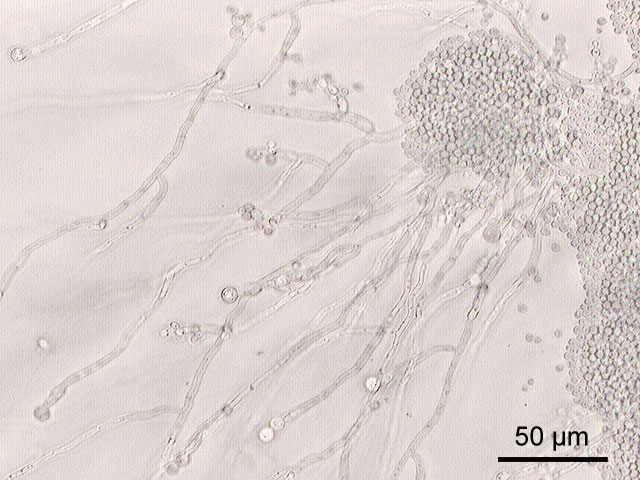|
Lactobacillus
''Lactobacillus'' is a genus of Gram-positive, aerotolerant anaerobes or microaerophilic, rod-shaped, non-spore-forming bacteria. Until 2020, the genus ''Lactobacillus'' comprised over 260 phylogenetically, ecologically, and metabolically diverse species; a taxonomic revision of the genus assigned lactobacilli to 25 genera (see below). ''Lactobacillus'' species constitute a significant component of the human and animal microbiota at a number of body sites, such as the digestive system, and the female genital system. In women of European ancestry, ''Lactobacillus'' species are normally a major part of the vaginal microbiota. ''Lactobacillus'' forms biofilms in the vaginal and gut microbiota, allowing them to persist during harsh environmental conditions and maintain ample populations. ''Lactobacillus'' exhibits a mutualistic relationship with the human body, as it protects the host against potential invasions by pathogens, and in turn, the host provides a source of nutrien ... [...More Info...] [...Related Items...] OR: [Wikipedia] [Google] [Baidu] |
List Of Microbiota Species Of The Lower Reproductive Tract Of Women
This is the list of healthy vaginal microbiota (VMB), which is defined as the group of species and genera that generally are found to have lack of symptoms, absence of various infections, and result in good pregnancy outcomes. VMB is dominated mainly by Lactobacillus species. This is the list of organisms that are found in the lower reproductive tract of sexually mature women who are not immunocompromised. A partial description of pathogens that can be found in the lower and upper reproductive tract of women can be found in the article sexually transmitted disease. The organisms listed below are capable of causing illness if for some reason there is a change in vaginal pH or a change in the ratio of one organism to another. For example, '' Candida'' is a normal inhabitant of a healthy reproductive tract but an overgrowth of this organism can cause candidiasis. Normal microbiota This is the list of the normal flora that are found in the lower reproductive tract of sexual ... [...More Info...] [...Related Items...] OR: [Wikipedia] [Google] [Baidu] |
Lactobacillus Crispatus
''Lactobacillus crispatus'' is a common, rod-shaped species of genus ''Lactobacillus'' and is a hydrogen peroxide (H2O2) producing beneficial microbiota species located in both the vagina, through vaginal discharge, and the vertebrate gastrointestinal tract. The strain CTV-05 is used as a probiotic that can be used by premenopausal and postmenopausal women that experience recurrent urinary tract infections. It is being evaluated specifically for the prevention and treatment of bacterial vaginosis, which is characterized by the absence of ''Lactobacillus'' flora necessary to protect the host from infection. History The species name derives from Latin , meaning "curled", referring to the shape of the bacteria. ''L. crispatus'' was first isolated in 1953 by Brygoo and Aladame, who proposed it as a new species of the genus ''Eubacterium''. In the 1970s the type strain VPI 3199 (ATCC 33820) of ''L. crispatus'' (at the time still designated "''Eubacterium crispatum''") was deposited i ... [...More Info...] [...Related Items...] OR: [Wikipedia] [Google] [Baidu] |
Probiotic
Probiotics are live microorganisms promoted with claims that they provide health benefits when consumed, generally by improving or restoring the gut microbiota. Probiotics are considered generally safe to consume, but may cause bacteria- host interactions and unwanted side effects in rare cases. There is some evidence that probiotics are beneficial for some conditions, but there is little evidence for many of the health benefits claimed for them. The first discovered probiotic was a certain strain of bacillus in Bulgarian yoghurt, called ''Lactobacillus bulgaricus''. The discovery was made in 1905 by Bulgarian physician and microbiologist Stamen Grigorov. The modern-day theory is generally attributed to Russian Nobel laureate Élie Metchnikoff, who postulated around 1907 that yoghurt-consuming Bulgarian peasants lived longer. A growing probiotics market has led to the need for stricter requirements for scientific substantiation of putative benefits conferred by microorgan ... [...More Info...] [...Related Items...] OR: [Wikipedia] [Google] [Baidu] |
Lactobacillus Delbrueckii
''Lactobacillus delbrueckii'' is a species of bacteria in the family Lactobacillaceae. It is part of the microbiota of the lower reproductive tract of women. History Naming The species carries the name of Max Delbrück Max Ludwig Henning Delbrück (; September 4, 1906 – March 9, 1981) was a German–American biophysicist who participated in launching the molecular biology research program in the late 1930s. He stimulated physical scientists' interest int ..., who lent his name to the Berlin Institute for the Fermentation Industries, where ''L. delbrueckii'' and ''L. delbrueckii'' subsp. ''bulgaricus'' were produced on an industrial scale from about 1896. (Delbrück's Institute was located in East Berlin and around 1967 it was renamed ''Institut für Gärungsgewerbe und Biotechnologie zu Berlin (IFGB)''.Philippe Goujon (2001). From Biotechnology to Genomes: The Meaning of the Double Helix.) Subspecies A paper published in 1983 by Weiss, Schillinger, and Kandler, ... [...More Info...] [...Related Items...] OR: [Wikipedia] [Google] [Baidu] |
Lactobacillus Plantarum
''Lactiplantibacillus plantarum'' (formerly ''Lactobacillus arabinosus'' and ''Lactobacillus plantarum'') is a widespread member of the genus ''Lactiplantibacillus'' and commonly found in many fermented food products as well as anaerobic plant matter. ''L. plantarum'' was first isolated from saliva. Based on its ability to temporarily persist in plants, the insect intestine and in the intestinal tract of vertebrate animals, it was designated as a nomadic organism. ''L. plantarum'' is Gram positive, bacilli shaped bacterium. ''L. plantarum'' cells are rods with rounded ends, straight, generally 0.9–1.2 μm wide and 3–8 μm long, occurring singly, in pairs or in short chains. ''L. plantarum'' has one of the largest genomes known among the lactic acid bacteria and is a very flexible and versatile species. It is estimated to grow between pH 3.4 and 8.8. ''Lactiplantibacillus plantarum'' can grow in the temperature range 12 °C to 40 °C. The viable counts of the "L. plant ... [...More Info...] [...Related Items...] OR: [Wikipedia] [Google] [Baidu] |
Lactic Acid Bacteria
Lactobacillales are an order of gram-positive, low-GC, acid-tolerant, generally nonsporulating, nonrespiring, either rod-shaped ( bacilli) or spherical ( cocci) bacteria that share common metabolic and physiological characteristics. These bacteria, usually found in decomposing plants and milk products, produce lactic acid as the major metabolic end product of carbohydrate fermentation, giving them the common name lactic acid bacteria (LAB). Production of lactic acid has linked LAB with food fermentations, as acidification inhibits the growth of spoilage agents. Proteinaceous bacteriocins are produced by several LAB strains and provide an additional hurdle for spoilage and pathogenic microorganisms. Furthermore, lactic acid and other metabolic products contribute to the organoleptic and textural profile of a food item. The industrial importance of the LAB is further evidenced by their generally recognized as safe (GRAS) status, due to their ubiquitous appearance in food and ... [...More Info...] [...Related Items...] OR: [Wikipedia] [Google] [Baidu] |
Gut Flora
Gut microbiota, gut microbiome, or gut flora, are the microorganisms, including bacteria, archaea, fungi, and viruses that live in the digestive tracts of animals. The gastrointestinal metagenome is the aggregate of all the genomes of the gut microbiota. The gut is the main location of the human microbiome. The gut microbiota has broad impacts, including effects on colonization, resistance to pathogens, maintaining the intestinal epithelium, metabolizing dietary and pharmaceutical compounds, controlling immune function, and even behavior through the gut–brain axis. The microbial composition of the gut microbiota varies across regions of the digestive tract. The colon contains the highest microbial density recorded in any habitat on Earth, representing between 300 and 1000 different species. Bacteria are the largest and to date, best studied component and 99% of gut bacteria come from about 30 or 40 species. Up to 60% of the dry mass of feces is bacteria. Over 99% of the b ... [...More Info...] [...Related Items...] OR: [Wikipedia] [Google] [Baidu] |
Lactobacillaceae
The ''Lactobacillaceae'' are a family of lactic acid bacteria. It is the only family in the lactic acid bacteria which includes homofermentative and heterofermentative organisms; in the ''Lactobacillaceae,'' the pathway used for hexose fermentation is a genus-specific trait. ''Lactobacillaceae'' include the homofermentative lactobacilli ''Lactobacillus'', ''Holzapfelia'', ''Amylolactobacillus'', ''Bombilactobacillus'', ''Companilactobacillus'', ''Lapidilactobacillus'', ''Agrilactobacillus'', ''Schleiferilactobacillus'', ''Loigolactobacillus'', ''Lacticaseibacillus'', ''Latilactobacillus'', ''Dellaglioa'', ''Liquorilactobacillus'', ''Ligilactobacillus'', and ''Lactiplantibacillus''; the heterofermentative lactobacilli ''Furfurilactobacillus'', ''Paucilactobacillus'', ''Limosilactobacillus'', ''Fructilactobacillus'', ''Acetilactobacillus'', ''Apilactobacillus'', ''Levilactobacillus'', ''Secundilactobacillus'', and ''Lentilactobacillus,'' which were previously classified in the genus ... [...More Info...] [...Related Items...] OR: [Wikipedia] [Google] [Baidu] |
Human Microbiota
This article lists some of the species recognized as belonging to the human microbiome. Whole-body distributed *''Acinetobacter calcoaceticus'' *''Burkholderia cepacia'' *''Pseudomonas pseudoalcaligenes'' *''Peptostreptococcus spp'' Natural cavities *''Fusobacterium necrophorum'' *''Eubacterium spp'' *'' Microbacterium spp'' Skin *''Acinetobacter spp'' *''Bacillus spp'' *''Candida albicans'' *''Candida parapsilosis'' *''Corynebacterium spp'' *''Corynebacterium parvum'' *''Cutibacterium acnes'' *''Demodex folliculorum'' *''Enterobacter cloacae'' *'' Epidermophyton floccosum'' *''Micrococcus spp'' *'' Micrococcus luteus'' *''Mycobacterium spp'' *''Neisseria spp'' *''Peptostreptococcus spp'' *'' Malassezia ovale'' *''Propionibacterium spp'' *''Pseudomonas aeruginosa'' *'' Sarcina spp'' *''Staphylococcus aureus'' *''Staphylococcus epidermidis'' *'' Staphylococcus haemolyticus'' *''Streptococcus viridans'' *''Trichophyton spp'' Hair follicles *''Staphylococcus aureus'' ... [...More Info...] [...Related Items...] OR: [Wikipedia] [Google] [Baidu] |
Phosphoketolase
The enzyme phosphoketolase() catalyzes the chemical reactions :D-xylulose 5-phosphate + phosphate \rightleftharpoons acetyl phosphate + D-glyceraldehyde 3-phosphate + H2O () :D-fructose 6-phosphate + phosphate \rightleftharpoons acetyl phosphate + D-erythrose 4-phosphate + H2OEC 4.1.2.22 :D-sedoheptulose 7-phosphate + phosphate \rightleftharpoons acetyl phosphate + D-ribose 5-phosphate + H2O Phosphoketolase is considered a promiscuous enzyme because it was demonstrated to use 3 different sugar phosphates as substrates. In a recent genetic study, more than 150 putative phosphoketolase genes exhibiting varying catalytic properties were found in 650 analyzed bacterial genomes. This enzyme belongs to the family of lyases, specifically the aldehyde-lyases, which cleave carbon-carbon bonds. It participates in 3 metabolic pathways: pentose phosphate pathway, methane metabolism, and carbon fixation. It employs one cofactor, thiamin diphosphate. Phosphoketolase was previously us ... [...More Info...] [...Related Items...] OR: [Wikipedia] [Google] [Baidu] |
Microaerophilic
A microaerophile is a microorganism that requires environments containing lower levels of dioxygen than that are present in the atmosphere (i.e. < 21% O2; typically 2–10% O2) for optimal growth. A more restrictive interpretation requires the microorganism to be obligate in this requirement. Many microaerophiles are also , requiring an elevated concentration of (e.g. 10% CO2 in the case of '''' |
Bacteria
Bacteria (; singular: bacterium) are ubiquitous, mostly free-living organisms often consisting of one Cell (biology), biological cell. They constitute a large domain (biology), domain of prokaryotic microorganisms. Typically a few micrometres in length, bacteria were among the first life forms to appear on Earth, and are present in most of its habitats. Bacteria inhabit soil, water, Hot spring, acidic hot springs, radioactive waste, and the deep biosphere of Earth's crust. Bacteria are vital in many stages of the nutrient cycle by recycling nutrients such as the nitrogen fixation, fixation of nitrogen from the Earth's atmosphere, atmosphere. The nutrient cycle includes the decomposition of cadaver, dead bodies; bacteria are responsible for the putrefaction stage in this process. In the biological communities surrounding hydrothermal vents and cold seeps, extremophile bacteria provide the nutrients needed to sustain life by converting dissolved compounds, such as hydrogen sulp ... [...More Info...] [...Related Items...] OR: [Wikipedia] [Google] [Baidu] |





